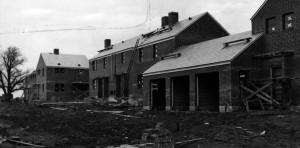Reprint
Greenhills birthed 75 years ago
 |
| Greenhills housing under construction in April 1937. Enquirer file |
Built by government as New Deal project
By Jeff Suess
jsuess@enquirer.com
The village of
Greenhills, a greenbelt community in northern Hamilton County built by the
federal government as part of President Franklin D. Roosevelt’s New Deal, has
turned 75 years old.
The first residents
moved to Avenell Lane on April 1, 1938.
Nestled within Winton
Woods, surrounded by forest, Greenhills still has the look of an early suburban
town. Most of the original buildings are still in use, and the historic
district is listed on the National Register of Historic Places.
Wendel Fisher has been living in Greenhills
since nearly the beginning. His family moved to a house on Bachman Street in
June 1938, when he was 2 years old.
He recalls bygone days
of ice cream socials and the whole neighborhood partaking in grillouts of blue
gill that some of the men had caught in Sharon Woods.
But, times change,
people change. Neighborhoods aren’t as neighborly.
“It doesn’t seem like
it was when I was growing up,” Fisher said. “We didn’t have television in the
’40s, and, of course, the war was going on.”
 |
| April 7, 1937: Greenhills housing project. |
Back in 1935, the
Resettlement Administration planned to build 25 cooperative towns surrounded by
greenspace of forests and farmland, hence the term “greenbelt.” It was an
experiment in community planning that also provided work and middle-income
housing during the Great Depression.
Greenhills was the
third village completed, after Greenbelt, Md., and Greendale, Wis. Then the
program ran out of money.
Greenhills alone cost
$11.5 million, which included purchasing 5,360 acres of land in Springfield
Township. About 3,300 workers spent 4.3 million man-hours constructing the town,
and many of them became its first residents.
The land north of town
was divided into large farms, where residents would come for fresh milk and
produce.
In 1939, the forest to
the south was handed over to the Hamilton County Park Board to form Winton
Woods.
Fisher remembers his
mother talking about the application process to join Greenhills. Government
officials came out and interviewed their neighbors in Westwood to determine
their moral character and make sure they would maintain the property.
The government
required residents to have a steady job, making between $1,000 and $2,500 a
year – that would be $16,000 to $40,000 today. This stipulation kept many of
the poorest in Cincinnati from moving in.
Income was checked
every year, and those who exceeded the maximum were asked to leave.
Only white families
were accepted, though that was in an era when segregation was common.
Most of the 676
dwellings were apartments or multifamily townhouses, with only a few
stand-alone homes. Many apartments had a modern style with flat roofs for easy
maintenance.
All units were rented,
not purchased, with an average rent of $27.62 a month ($441 in 2013 dollars).
Planners Justin Hartzog, who also helped plan Mariemont, and
William Strong had the roads follow the natural rolling topography, with
housing on dead-end side streets to cut down on traffic and make it safer for
children to play.
 |
| December 21, 1959: Greenhills' Shopping Center was one of the first strip malls in Ohio. Enquirer file |
Everything a town needed was near one street,
making it a walking community. The shopping center was one of the first strip
malls in Ohio.
The Greenhills
Community Building housed a library, gym and movie facilities, as well as two
Works Progress Administration murals by Paul Chidlaw and Richard Zoellner.
After World War II,
Uncle Sam decided to sell off the greenbelt towns, ending the community
experiment. On Dec. 9, 1949, the Greenhills Home Owners Corp., a nonprofit
tenant group, purchased 610 acres of Greenhills for $3.5 million. The tenants
then bought the properties they had been renting.
New one-family houses
of the typical suburban style were built, turning Greenhills into a bedroom
community. The northern farmland was sold in 1952 to create New Greenhills,
which was instead named Forest Park.
Fisher bought his own
home in the “newer section” of town in 1962. After 37 years at Cincinnati Bell,
he now volunteers at the Greenhills Historical Society sorting through the
archives.
The population in 2010
was down to 3,615, about what it was in 1950.
In 2009, longtime
residents protested when officials tore down 52 of the original flat-roof
apartments that had been neglected, even though they were on the historic
registry.
Now, for its diamond
anniversary, Greenhills is celebrating its past with community events all year
long.
“We have a pretty
engaged community,” said Greenhills Mayor Fred Murrell. “A lot of people are
proud of the village and happy to celebrate it.”
Greenhills, perhaps, hasn’t really changed
that much.
No comments:
Post a Comment